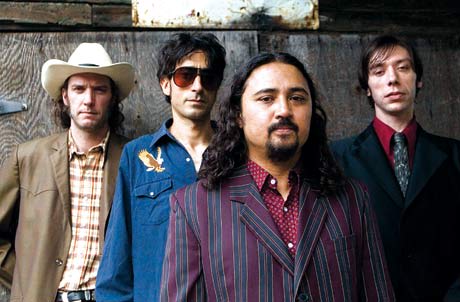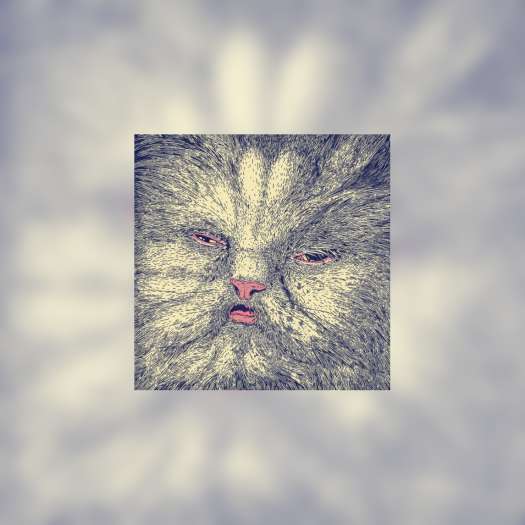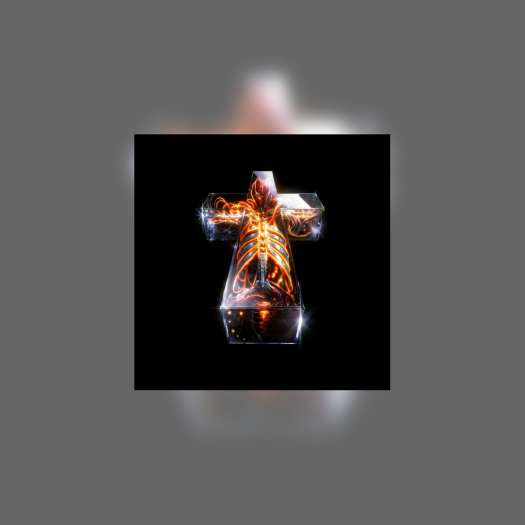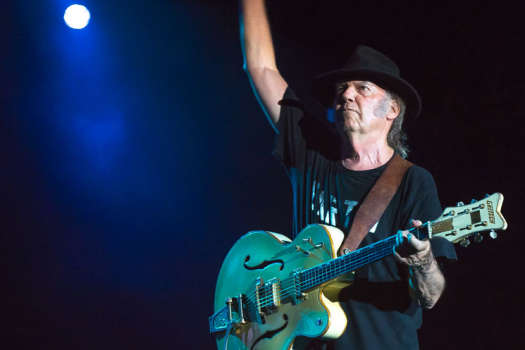1. The Sadies New Seasons (Outside)
The new season for the Sadies definitely isnt fall; here, they soar to new creative heights, delivering an album thats been unanimously proclaimed their best. Yet that claim somehow devalues the excellent music these honky-tonk heroes produced over the course of four earlier studio albums, not to mention killer collaborations with the likes of Neko Case, Jon Langford, Jon Spencer and their Rat Fink soundtrack.
The album is the groups most creatively coherent to date, with the prevailing mood suggesting the psychedelia meets cosmic country cowboy vibe of such pioneering outfits as the Byrds and Flying Burrito Brothers, not to mention Keelor-led Blue Rodeo. Recruiting Gary Louris as producer proved one smart move. The layered vocal harmonies essential to his own band, the Jayhawks, are a key to the success of New Seasons, with the voices of Dallas and Travis Good (and Louris) meshing seamlessly (the gorgeous "A Simple Aspiration is a prime example).
"That was something I was hoping he could bring to the forefront, says Dallas Good. "What I was surprised by was how musically in synch we were on every other aspect of what makes the Sadies. Gary gave me a whole different approach to how I would write a song, in his attention to fine detail. He was definitely the right guy for the job.
Travis Good is equally complimentary. "We had a lot of songs that werent written when we went in and hed help us with the arranging. He sat with us while we wrote songs, guiding us and telling us what he thought a song would need without actually saying OK, do this or that.
For New Seasons, the Sadies adopted a different approach, as Travis explains. "We just wanted to try writing stuff in the studio. Not completely from scratch, but every time someone would have an idea, from a line or a little instrumental bit to almost a complete song. We especially did that in Spain, where we recorded the first half. That was such a nice and inspiring environment. This was also down to wanting to use Gary as much as possible. If we had written and practiced for months before going to Spain, then chances are wed be set in our ways, and Gary would largely have been engineering.
The Sadies dont take accolades for granted. "Weve been on both sides of the pendulum, and I sure do appreciate the praise, notes Dallas. "If people say this is a notch above the rest then Ill take that as an evolutionary compliment, as opposed to a What the fuck am I gonna do now? Its so much more of an uphill battle when you dont have the support of your peers and the music scene you want to be a part of.
"It does feel like people are in our corner for this one, agrees Travis. "I always think every single record Ive made is the best weve ever done, but I also often second-guess these things, which makes the process a little more nerve-wracking. Our scene is indeed enriched greatly by the Sadies. Their success proves good guys can come first. Long may they ride. Kerry Doole
2. Wilco Sky Blue Sky (Nonesuch)
With every record, Jeff Tweedy and Wilco seem to pursue new muses with new musicians. Long gone are Jay Bennetts tasty licks, A Ghost Is Borns overt minimalism, and Tweedys obscure aquarium drinkers. More Steely Dan and Rolling Stones than Uncle Tupelo or Sonic Youth, Sky Blue Sky continues to indulge Tweedys experimental side, but embraces subtlety and deft songcraft over abstract sonic tinkering. Nels Clines guitar prowess and the groups newfound collaborative spirit anchor the record, an effort that will one day be regarded as the bands high water mark, and hopefully the beginning of a new creative renaissance. Patrick Finch
3. The Acorn Glory Hope Mountain (Paper Bag)
After several EPs, Ottawas the Acorn finally unleashed their full potential with this sprawling, dream-like record that fully captured the beauty and mystery of the wilderness surrounding them. As Rolf Klauseners songs alternate between hushed ballads and expansive, drum-driven sing-alongs, there is truly a sense that the band is attempting to connect with some form of higher power. And by the end its hard to argue that they didnt achieve it. Glory Hope Mountain is the kind of brave CanRock experiment rarely heard since the peak years of the Rheostatics. Jason Schneider
4. Rock Plaza Central Are We Not Horses (Outside)
Its been a banner year for Rock Plaza Central. A Pitchfork recommendation for the soulful optimistic caterwaul and soaring strings of "My Children Be Joyful brought Neutral Milk Hotel comparisons and more buzz than a swarm of killer bees in an ungrounded speaker cabinet. Largely improvised arrangements cloak Chris Eatons passionately rickety voice and surreally human tale of robotic horses in genre-bending rhythms, horn lines, strings and group harmonies suitable for an apocalyptic barn party. If its time to start running towards the light, weve got a lot to be glad for with Rock Plaza as the gleefully drunken soundtrack. Scott A. Gray
5. Robert Plant & Alison Krause Raising Sand (Rounder)
Robert Plant and Alison Krauss seem like an odd collaborative pair. While Krauss reigns over bluegrass, Plant triumphs over rocknroll; where Krausss rural twang charms the heart, Plants psychedelic flourishes hypnotise the mind. But together, the two musicians tiptoe outside their comfort zones to explore one anothers, and during this mystical, wandering voyage there emerges the common thread that is Raising Sand. Rootsy, bluesy, and shining with a rich veneer of organic sensibilities, Raising Sand truly demonstrates what it means to experiment with the unknown. Theres no duet album that is as alive or invigorating as Raising Sand. Amanda Ash
6. Iron & Wine The Shepherds Dog (Sub Pop)
Subtle, gorgeous instrumentation combined with an arty flair might have been a gamble it could have distracted from Sam Beams brittle and immaculately composed songs, but it didnt. What it did do is showcase how comprehensive and strong Beams talent really is. Every innovation on this album illuminates Beams lyrical might as his tiny epics really showcase the macro by looking at the micro. With every strum, handclap and warbling note, Beams complex simplicity hits its pinnacle. Theres a reason why the world assumes wisdom and experience from people with long beards. Chris Whibbs
7. Great Lake Swimmers Ongiara (Nettwerk)
Tony Dekker chief song catcher behind the Great Lakes Swimmers takes a page from Romantic poets like William Wordsworth and John Keats to find inspiration here. Raised along the shores of Lake Erie, the sombre songwriter knows a thing or two about how environment affects mood. Dekker uses this knowledge to paint haunting vignettes that linger long on your brain. Warm, lo-fi, and magical describes this listening session. Listen closely and you hear the hurt. Listen a little longer to decipher the beautiful despair. The sparse, acoustically inclined recordings allow the sound of each instrument to be heard behind Dekkers delicate delivery. David McPherson
8. Mark Davis Dont You Think We Should Be Closer? / Mistakes I Meant To Make (Saved By Radio)
When faced with overwhelming grief, few artists manage to mine the darkest of days for catharsis and beauty take a sad song and make it better, if you will. Alberta's Mark Davis makes the most of his Rocky Mountain mourning by writing timeless twilight melodies that are haunted by memories and holy ghosts, remembering a love that was "The Strongest I Have Known. Sky-high, spacious arrangements frame Davis's rich baritone, a courageous voice that cries its tears in private, well before he invites the audience in and offers what solace he can in the face of shocking, senseless events and endless sleepless nights. Michael Barclay
9. Vic Chesnutt North Star Deserter (Constellation)
Pairing together Vic Chesnutt with a selection of Constellation Records all-stars turned out to be a stroke of genius because Chesnutt hasnt sounded this vital in years. There are songs that could have come from his earliest records just him and his guitar but it is on the others where magic really happens. When combined with the wealth of other musicians, the macabre atmosphere adds another dimension to Chesnutts darkest lyrics. But it is the loudest, rawest songs, reminiscent of Low, might be the real revelation, yet they sound so very natural. This could be the start of a beautiful relationship. Michael Edwards
10. Jim Bryson Where the Bungalows Roam (Kelp)
Ottawa singer-songwriter Bryson has such great rock-pig chops - able to rip a gripping guitar solo and mumble his way through a charging chorus - that theres an initial shock to this quieter, more introspective effort. But spending time in Brysons neighbourhood reveals the simple pleasures of a thoughtful lyric and a subtle, beautiful organ stab. Employing the second person narrative perspective creates an intimacy between singer and listener that makes it seem like a shared conversation, with Bryson revealing more than perhaps he ever has. Quiet without being spare and intimate without being boring, Bungalows feels like an old friend. James Keast
The new season for the Sadies definitely isnt fall; here, they soar to new creative heights, delivering an album thats been unanimously proclaimed their best. Yet that claim somehow devalues the excellent music these honky-tonk heroes produced over the course of four earlier studio albums, not to mention killer collaborations with the likes of Neko Case, Jon Langford, Jon Spencer and their Rat Fink soundtrack.
The album is the groups most creatively coherent to date, with the prevailing mood suggesting the psychedelia meets cosmic country cowboy vibe of such pioneering outfits as the Byrds and Flying Burrito Brothers, not to mention Keelor-led Blue Rodeo. Recruiting Gary Louris as producer proved one smart move. The layered vocal harmonies essential to his own band, the Jayhawks, are a key to the success of New Seasons, with the voices of Dallas and Travis Good (and Louris) meshing seamlessly (the gorgeous "A Simple Aspiration is a prime example).
"That was something I was hoping he could bring to the forefront, says Dallas Good. "What I was surprised by was how musically in synch we were on every other aspect of what makes the Sadies. Gary gave me a whole different approach to how I would write a song, in his attention to fine detail. He was definitely the right guy for the job.
Travis Good is equally complimentary. "We had a lot of songs that werent written when we went in and hed help us with the arranging. He sat with us while we wrote songs, guiding us and telling us what he thought a song would need without actually saying OK, do this or that.
For New Seasons, the Sadies adopted a different approach, as Travis explains. "We just wanted to try writing stuff in the studio. Not completely from scratch, but every time someone would have an idea, from a line or a little instrumental bit to almost a complete song. We especially did that in Spain, where we recorded the first half. That was such a nice and inspiring environment. This was also down to wanting to use Gary as much as possible. If we had written and practiced for months before going to Spain, then chances are wed be set in our ways, and Gary would largely have been engineering.
The Sadies dont take accolades for granted. "Weve been on both sides of the pendulum, and I sure do appreciate the praise, notes Dallas. "If people say this is a notch above the rest then Ill take that as an evolutionary compliment, as opposed to a What the fuck am I gonna do now? Its so much more of an uphill battle when you dont have the support of your peers and the music scene you want to be a part of.
"It does feel like people are in our corner for this one, agrees Travis. "I always think every single record Ive made is the best weve ever done, but I also often second-guess these things, which makes the process a little more nerve-wracking. Our scene is indeed enriched greatly by the Sadies. Their success proves good guys can come first. Long may they ride. Kerry Doole
2. Wilco Sky Blue Sky (Nonesuch)
With every record, Jeff Tweedy and Wilco seem to pursue new muses with new musicians. Long gone are Jay Bennetts tasty licks, A Ghost Is Borns overt minimalism, and Tweedys obscure aquarium drinkers. More Steely Dan and Rolling Stones than Uncle Tupelo or Sonic Youth, Sky Blue Sky continues to indulge Tweedys experimental side, but embraces subtlety and deft songcraft over abstract sonic tinkering. Nels Clines guitar prowess and the groups newfound collaborative spirit anchor the record, an effort that will one day be regarded as the bands high water mark, and hopefully the beginning of a new creative renaissance. Patrick Finch
3. The Acorn Glory Hope Mountain (Paper Bag)
After several EPs, Ottawas the Acorn finally unleashed their full potential with this sprawling, dream-like record that fully captured the beauty and mystery of the wilderness surrounding them. As Rolf Klauseners songs alternate between hushed ballads and expansive, drum-driven sing-alongs, there is truly a sense that the band is attempting to connect with some form of higher power. And by the end its hard to argue that they didnt achieve it. Glory Hope Mountain is the kind of brave CanRock experiment rarely heard since the peak years of the Rheostatics. Jason Schneider
4. Rock Plaza Central Are We Not Horses (Outside)
Its been a banner year for Rock Plaza Central. A Pitchfork recommendation for the soulful optimistic caterwaul and soaring strings of "My Children Be Joyful brought Neutral Milk Hotel comparisons and more buzz than a swarm of killer bees in an ungrounded speaker cabinet. Largely improvised arrangements cloak Chris Eatons passionately rickety voice and surreally human tale of robotic horses in genre-bending rhythms, horn lines, strings and group harmonies suitable for an apocalyptic barn party. If its time to start running towards the light, weve got a lot to be glad for with Rock Plaza as the gleefully drunken soundtrack. Scott A. Gray
5. Robert Plant & Alison Krause Raising Sand (Rounder)
Robert Plant and Alison Krauss seem like an odd collaborative pair. While Krauss reigns over bluegrass, Plant triumphs over rocknroll; where Krausss rural twang charms the heart, Plants psychedelic flourishes hypnotise the mind. But together, the two musicians tiptoe outside their comfort zones to explore one anothers, and during this mystical, wandering voyage there emerges the common thread that is Raising Sand. Rootsy, bluesy, and shining with a rich veneer of organic sensibilities, Raising Sand truly demonstrates what it means to experiment with the unknown. Theres no duet album that is as alive or invigorating as Raising Sand. Amanda Ash
6. Iron & Wine The Shepherds Dog (Sub Pop)
Subtle, gorgeous instrumentation combined with an arty flair might have been a gamble it could have distracted from Sam Beams brittle and immaculately composed songs, but it didnt. What it did do is showcase how comprehensive and strong Beams talent really is. Every innovation on this album illuminates Beams lyrical might as his tiny epics really showcase the macro by looking at the micro. With every strum, handclap and warbling note, Beams complex simplicity hits its pinnacle. Theres a reason why the world assumes wisdom and experience from people with long beards. Chris Whibbs
7. Great Lake Swimmers Ongiara (Nettwerk)
Tony Dekker chief song catcher behind the Great Lakes Swimmers takes a page from Romantic poets like William Wordsworth and John Keats to find inspiration here. Raised along the shores of Lake Erie, the sombre songwriter knows a thing or two about how environment affects mood. Dekker uses this knowledge to paint haunting vignettes that linger long on your brain. Warm, lo-fi, and magical describes this listening session. Listen closely and you hear the hurt. Listen a little longer to decipher the beautiful despair. The sparse, acoustically inclined recordings allow the sound of each instrument to be heard behind Dekkers delicate delivery. David McPherson
8. Mark Davis Dont You Think We Should Be Closer? / Mistakes I Meant To Make (Saved By Radio)
When faced with overwhelming grief, few artists manage to mine the darkest of days for catharsis and beauty take a sad song and make it better, if you will. Alberta's Mark Davis makes the most of his Rocky Mountain mourning by writing timeless twilight melodies that are haunted by memories and holy ghosts, remembering a love that was "The Strongest I Have Known. Sky-high, spacious arrangements frame Davis's rich baritone, a courageous voice that cries its tears in private, well before he invites the audience in and offers what solace he can in the face of shocking, senseless events and endless sleepless nights. Michael Barclay
9. Vic Chesnutt North Star Deserter (Constellation)
Pairing together Vic Chesnutt with a selection of Constellation Records all-stars turned out to be a stroke of genius because Chesnutt hasnt sounded this vital in years. There are songs that could have come from his earliest records just him and his guitar but it is on the others where magic really happens. When combined with the wealth of other musicians, the macabre atmosphere adds another dimension to Chesnutts darkest lyrics. But it is the loudest, rawest songs, reminiscent of Low, might be the real revelation, yet they sound so very natural. This could be the start of a beautiful relationship. Michael Edwards
10. Jim Bryson Where the Bungalows Roam (Kelp)
Ottawa singer-songwriter Bryson has such great rock-pig chops - able to rip a gripping guitar solo and mumble his way through a charging chorus - that theres an initial shock to this quieter, more introspective effort. But spending time in Brysons neighbourhood reveals the simple pleasures of a thoughtful lyric and a subtle, beautiful organ stab. Employing the second person narrative perspective creates an intimacy between singer and listener that makes it seem like a shared conversation, with Bryson revealing more than perhaps he ever has. Quiet without being spare and intimate without being boring, Bungalows feels like an old friend. James Keast




